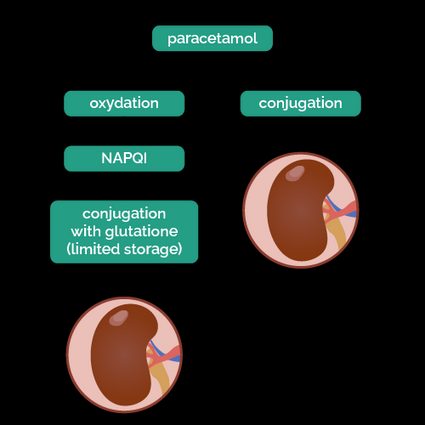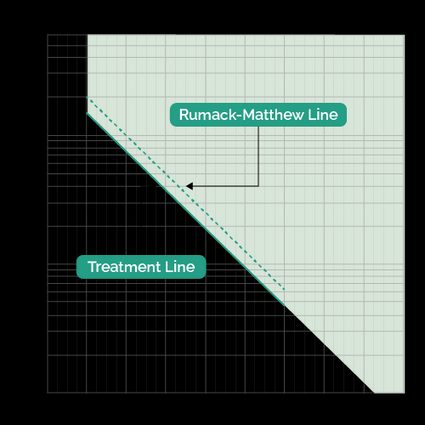Tylenol Overdose Calculator
Tylenol overdose calculator is a tool that works two ways: it lets you count the amount of N-acetylcysteine for paracetamol poisoning and allows you to estimate the drug's toxicity. We base the estimation and prognosis on the validated Rumack Matthew nomogram. Read on to find out what happens if you overdose on Tylenol and how NAC (N-acetylcysteine) works in your favor.
We try our best to make our Omni Calculators as precise and reliable as possible. However, this tool can never replace professional medical advice, diagnosis, or treatment. All information on this website is for informational purposes only and is not intended to and should not serve as a substitute for medical consultation. Always seek the advice of a health provider.
One substance, many names
💡 Tylenol is a product of paracetamol, and paracetamol is a different name for acetaminophen.
What is NAC for Tylenol overdose?
NAC (or N-acetylcysteine) for paracetamol poisoning acts as an antidote. If given , it virtually prevents liver damage — the deadliest consequence of Tylenol overdose.
Are there any alternatives to N-acetylcysteine? There is no other treatment validated to that extent, but the research is ongoing. Some promising substances include:
- ;
- ; and
- .
N-acetylcysteine — NAC — mechanism of action in paracetamol overdose
To understand the NAC mechanism of action in paracetamol poisoning, let's first understand what happens with the drug in our body. Take a look at the picture:

When you take Tylenol in regular, therapeutic doses, the substance is processed by two mechanisms. Most of the paracetamol breakdown happens with the process of conjugation (95% of it). Only 5% of the drug amount is oxidized. Oxidation leads to the production of a small amount of a toxic metabolite, NAPQI (N-acetyl-p-benzoquinoneimine). It can cause liver necrosis (death of the liver cells). Luckily, we have a mechanism for neutralizing NAPQI using a glutathione molecule. NAPQI is conjugated and excreted with urine.
When there is too much acetaminophen, more substance follows the oxidation pathway, producing more toxic NAPQI. Here comes the problem, as we only have limited glutathione storage. Being unable to neutralize all the deadly NAPQI molecules, we're prone to its damaging properties. That's why the main consequence of paracetamol overdose is liver failure.
What is NAC for Tylenol overdose? It works in two ways:
- It is a substrate for glutathione production — which can give us more glutathione and more neutralizing possibilities,
- It forces more paracetamol molecules to follow the conjugation pathway.
Two actions combined give us a bigger chance to save our liver cells from the toxic NAPQI.
How to calculate acetaminophen overdose antidote doses
To calculate the amount of N-acetylcysteine (NAC) to administer to the patient, you first have to know their weight and route of administration (oral or intravenous).
Per os route (oral)
-
To count the first dose of NAC given p.o., you have to multiply the patient's weight in kg (kilograms) by 140 mg.
first dose [mg] = weight [kg] × 140 mg -
For the second and consecutive doses, you have to multiply the patient's weight in kg by 70 mg.
next dose [mg] = weight [kg] × 70 mg
IV route (intravenous)
-
To count the first dose, you have to multiply the patient's weight in kg by 150 mg
first dose [mg] = weight [kg] × 150 mg -
For the second dose, multiply the patient's weight in kg by 50 mg
second dose [mg] = weight [kg] × 50 mg -
For the third (last dose), multiply the patient's weight in kg by 100 mg
third dose [mg] = weight [kg] × 100 mg
Keep in mind that the maximum dose to give to any patient intravenously is as if they weighed 110 kg, meaning maximum doses, consecutively, of 16500 mg, 5500 mg, and 1100 mg.
In the intravenous route case, you also must consider how much diluent to use. Fortunately, that's simple:
Patient's weight | Diluent - 1st dose | Diluent - 2nd dose | Diluent - 3rd dose |
|---|---|---|---|
up to 20 kg | weight × 3 mL/kg | weight × 7 mL/kg | weight × 14 mL/kg |
20-40 kg | 100 mL | 250 mL | 500 mL |
>40 kg | 200 mL | 500 mL | 1000 mL |
Using Tylenol overdose calculator — how to calculate acetaminophen overdose
Using our Tylenol overdose calculator is easy. Follow the steps:
-
Input the patient's weight (in kg or lb — as you prefer).
-
Check the route of NAC administration — intravenous or oral. The intravenous way is faster and more convenient.
-
You will see immediately how much N-acetylcysteine for paracetamol poisoning you should give. You will have it divided into particular doses. If you choose the
intravenous route, the calculator will also count the amount of diluent to give. -
To check if the blood paracetamol concentration is dangerous, click on the "Acetaminophen toxicity" section of the calculator and input the current acetaminophen blood level and hours that have passed since the Tylenol ingestion. Warning: The calculator works accurately only if there is a single ingestion of paracetamol.
-
Based on the lab test result and Rumack Matthew nomogram, the Tylenol overdose calculator will tell you if that concentration falls into the toxic or therapeutic range.
Rumack Matthew nomogram (acetaminophen NAC nomogram)
Barry Rumack and Henry Matthew were the first scientists who, based on their research, proposed a nomogram to solve the problem of how to calculate acetaminophen overdose. They observed that acetaminophen concentration measured at a particular point in time is a prognostic value.
Nowadays, we can observe the second line called the 'treatment line'. It indicates at which paracetamol level we should start treating patients with NAC. We calculate it as 0.75 (3/4) of the toxic level. The nomogram is sometimes called acetaminophen-NAC nomogram because of the connection between the drug and the antidote.

Acetaminophen poisoning stages
Acetaminophen poisoning stages include four phases of developing liver failure. The phases are only accurate if NAC, or at least an alternative to N-acetylcysteine, is not administered quickly.
There are four stages of paracetamol poisoning:
- First phase occurs in the first 24 hours after toxic dose ingestion. The patient might experience weakness, nausea, and vomiting.
- The second phase encompasses a period usually from the first to the third day of the intoxication. There is visible jaundice (yellowish coloration of the skin and mucous membranes) and pain in the abdomen's upper right quarter. In the lab test, you might detect hypoglycemia, high AST and ALT values, and metabolic acidosis. To learn more about the concept, use Omni AST and ALT calculator.
- Third phase is crucial, as it is the phase of fulminant liver failure. It lasts from day 3 to day 5. The patient is in a terrible state, usually encephalopathic, hemodynamically unstable, and at risk of massive bleeding due to coagulation system failure. Circulation problems can lead to further failure of the other organs, such as kidneys. If you're interested in risk factors for kidney disease and failure, visit kidney failure risk calculator.
- Fourth stage is either liver regeneration or the patient's death in a more unfortunate case.
The following groups are more prone to paracetamol overdose:
- Infants;
- The elderly;
- Persons who are malnourished;
- Patients with malabsorption issues; and
- Those who are alcohol dependent – to detect problematic alcohol consumption patterns, visit AUDIT-C screen calculator.
FAQs
How do I calculate N-acetylcysteine to give a child who weighs 15 kg?
To count how much N-acetylcysteine you should give to a 15 kg child:
First, determine the route of N-acetylcysteine administration — whether orally or intravenously.
If intravenously (IV):
- Multiply the child's weight by 150 mg for the first loading dose:
15 × 150 mg = 2250 mg = 2.25 g
Loading dose = 2.25 g of NAC iv - Multiply the child's weight by 50 mg for the second dose:
15 × 50 mg = 750 mg = 0.75 g
Second dose = 0.75 g of NAC iv - Multiply the child's weight with 100 mg for the last (third dose):
15 × 100 mg = 1500 mg = 1.5 g
Third dose = 1.5 g of NAC iv
If orally (PO):
- Multiply the child's weight by 140 mg for the first dose:
15 × 140 mg = 2100 mg = 2.1 g
First dose = 2.1 g of NAC po - Multiply the child's weight by 70 mg for the next 17 doses:
15 x 70 mg = 1050 mg = 1.05 g
The17 doses = 1.05 g of NAC po
You can also use our Tylenol overdose calculator to count that for you.
How to stop paracetamol overdose?
To stop paracetamol overdose, get the patient to the Emergency Room as fast as possible. If the ingestion happened less than an hour ago, vomiting could help, but that should never delay transport to the hospital. Don't try any homemade alternatives to N-acetylcysteine. Acetaminophen overdose is a severe medical state and should be treated and monitored in hospital conditions.
What is the antidote for Tylenol overdose?
The antidote for Tylenol overdose is N-acetylcysteine (NAC). However, you might find reports about other substances trials as a paracetamol overdose antidote. The list includes methionine, ethyl pyruvate, and cimetidine.
What happens if you overdose on Tylenol?
If you overdose on Tylenol and don't get an antidote fast:
- First, you'll experience nausea, feeling weak and unwell.
- In the next phase, you might observe yellow coloration on the skin (jaundice), and pain in your right upper belly region may appear.
- The third phase is acute liver failure — confusion, shock, loss of consciousness, and massive bleeding.
- The fourth phase is either death or liver regeneration.